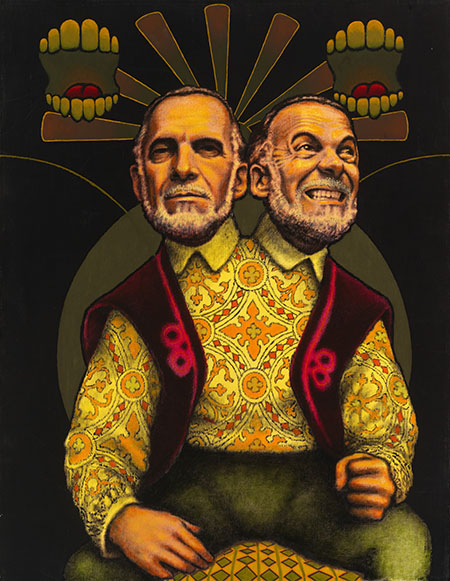Painthing on the Möve: Chicago Imagists 1966–1973

In 1951, a year after 18 irascible New York artists posed for a now-infamous black and white photograph, Jean Dubuffet delivered a lecture entitled ‘Anticultural Positions’ to a rapt audience at the Arts Club of Chicago. Dubuffet’s idea of an anti-art aesthetic fell on fertile ground in the Windy City, planting seeds of inspiration for a group of artists who would later reject the tenets of Abstract Expressionism, and would daub dirty jokes over the clean, commercial facsimiles suggested by New York’s Pop exports. The Chicago Imagists, a group of artists bound by their liberal use of colour and bold design, would create a body of work that was a mix of the absurd, nervous energy found in 1960s underground American comics, cut with a wry sense of humour pitched somewhere between the bar-room and the schoolyard.
Rather than uniting under the strict edicts of a published manifesto, the Imagists were a loose collection of individuals who – during the late 1960s and early ’70s – exhibited together under the curatorial eye of artist Don Baum. The closest thing to a formal group within the latterly identified Imagists camp was a party of six artists known as The Hairy Who, featuring Jim Nutt, Karl Wirsum and Art Green among others. This group, alongside artists like Ed Paschke, Barbara Rossi and Roger Brown, would all figure in Baum’s exhibitions at the Hyde Park Art Center. ‘Painthing on the Möve’ at Thomas Dane Gallery, brought together a collection of works, seldom seen in Europe, by nine artists selected from the two factions of the larger Imagist group.
Curated jointly by John Corbett, of Chicago’s Corbett vs. Dempsey gallery, and Albert Oehlen (who had a parallel exhibition of his own works at Thomas Dane’s new space, further down Duke Street), the show’s mix of sculpture, assemblage and painting was spread across the gallery’s two main rooms and a corridor. Nutt, one of the best-known and still currently active Imagists (he was the subject of a 2011 retrospective at the Museum of Contemporary Art, Chicago), was well represented. Sick Head (1967–8), a painting of an amorphous fleshy mess attached to an electrolysis machine, practically jumped from the wall. Created with his signature technique of applying acrylic paint to the reverse side of a Perspex panel, the picture’s yellows, pinks and reds pulsed with a vivid urgency that belied their age. Offsetting Nutt’s blast of colour were four of his delicately lined etchings: each compact picture neatly framed the kind of brilliantined greaser heroes and molls you’d find tattooed on the arms of tough guys of 1950s and ’60s American legend. Wirsum’s Boxer (1967), a small papier-mâché goon pulled from the same pulp universe, glared out from a glass-topped plinth in the centre of the second space.
Vibrant graphic work in Green’s Protective Coloration (1969) and Untimely Interruption (1973) haven’t dated so well. Something about their kitschy, Dalí-meets-the-automobile aesthetic makes them feel more suited to teenage boys’ bedspreads than gallery walls. By far the strangest, and most beguiling, pieces on display were Robert Lostutter’s. Both untitled watercolours from 1970, they position the viewer as a submissive john, looking up the tiny skirts of two gigantic women.
The problem with the Chicago Imagists, art-historically speaking, is that nobody seems to know where to put them. Somewhere between the Abstract Expressionists and Pop artists, some would argue; a rogue group of anti-New York, anti-Europeans influenced by outsider art, say others (this is the angle Corbett takes in his exhibition catalogue essay). Even Oehlen, in the catalogue, says: ‘I’m not sure what it has to do with me, but it reminds me of my first encounters with Pop art.’ The truth is the Imagists’ influence reached beyond the confines of the art world, into the radical subculture/pop culture crossovers of 1980s America: from Art Spiegelman’s comic-book anthology RAW (1980–91) – which featured Gary Panter, Mark Beyer, Charles Burns and Kim Deitch – to the animated idents of early MTV, Max Headroom, the music videos of bands like Was (Not Was) (see ‘Dad I’m in Jail’ from 1988), and the anarchy of Pee-wee’s Playhouse and early Nickelodeon. The great thing about ‘Painthing on the Möve’ was that it offered a brief glimpse into the lurid visions of this underexposed group of exciting and innovative artists. Let’s hope it’s a major retrospective next time.
















